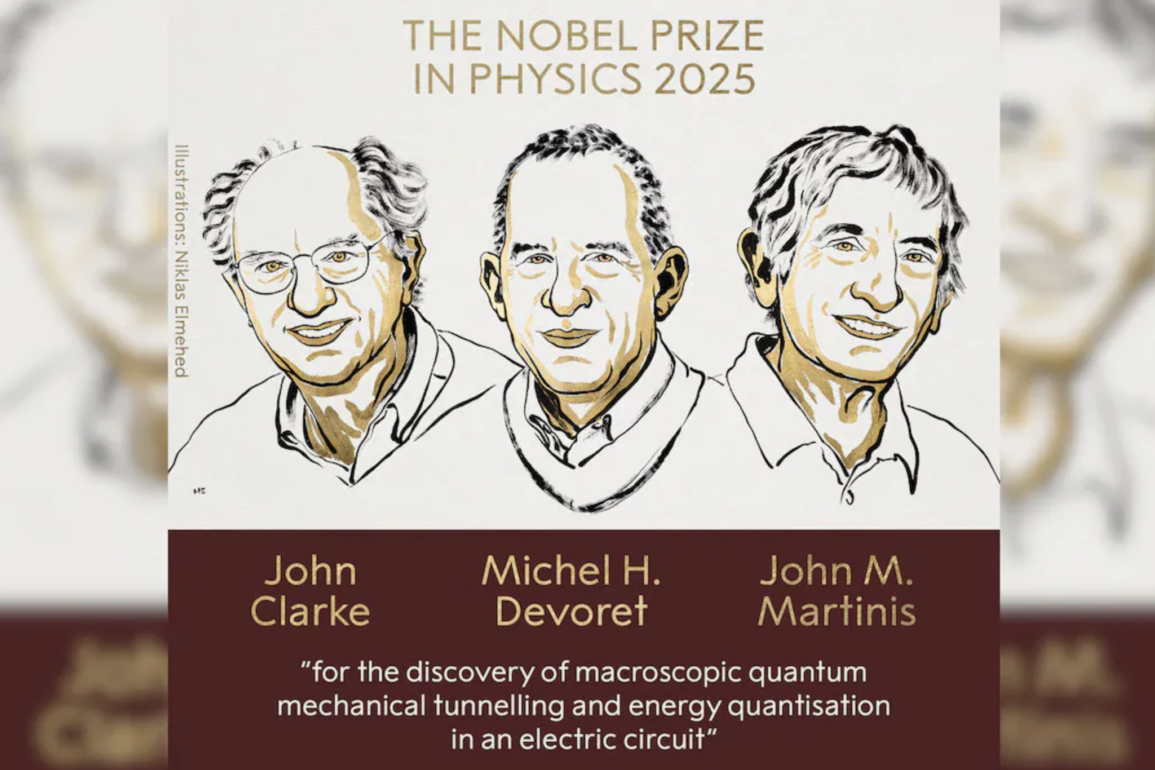The 2025 Nobel Prize in Physics has been awarded to John Clarke, Michel H. Devoret, and John M. Martinis for pioneering experiments that revealed how the strange rules of quantum mechanics, once thought confined to the atomic realm, could govern the behavior of macroscopic electrical circuits.
Their discoveries, made in the 1980s, have since become the cornerstone of quantum computing, a technology poised to transform industries from medicine to finance to artificial intelligence.
“There is no advanced technology used today that does not rely on quantum mechanics, including mobile phones, cameras… and fibre optic cables,” the Nobel Committee said in its announcement, made by the Royal Swedish Academy of Sciences at a press conference in Stockholm.
The three scientists will share 11 million Swedish kronor (about £872,000) for their work, which the committee summarized as the discovery of “macroscopic quantum mechanical tunneling and energy quantisation in an electric circuit.”
To the uninitiated, the phrase may sound opaque. But its implications have reverberated through both theoretical and applied physics for decades.
A Quantum Surprise
Speaking moments after the announcement, Professor John Clarke, a British-born physicist at the University of California, Berkeley, expressed astonishment at receiving the field’s highest honor.
“To put it mildly, it was a surprise of my life,” he said by phone. “I’m completely stunned. At the time we did not realise in any way that this might be the basis for a Nobel prize.”
His experiments, performed more than forty years ago, demonstrated something that had previously seemed impossible: that entire electrical circuits could behave according to the rules of quantum mechanics — a theory developed to describe particles at subatomic scales.
“This is something that leads to development of the quantum computer,” Clarke said. “Many people are working on quantum computing, our discovery is in many ways the basis of this.”
From Theory to Circuits
Quantum mechanics describes how particles like electrons behave in ways that defy classical intuition — appearing in two places at once, or tunneling through barriers that should be impenetrable.
Clarke, along with Michel H. Devoret of Yale University and John M. Martinis of the University of California, Santa Barbara, conducted experiments that demonstrated these effects at a scale large enough to be observed and controlled within electrical circuits.
More Quantum From Afcacia:
-
They Made Quantum Weirdness Visible. Now, It’s Changing the Future of Computing.
-
A Quantum Leap That Lasts Forever? Harvard Scientists May Have Found the Key
-
Quantum Leap or Quantum Risk? Balancing Innovation and Security in South Africa
Using superconducting materials cooled to near absolute zero, their circuits allowed electrons to perform a kind of subatomic acrobatics known as quantum tunneling — slipping through energy barriers that classical physics would deem insurmountable. The finding proved that quantum behavior could exist not just in atoms, but in systems built by human hands.
The trio’s results were revolutionary: they bridged the gap between the invisible quantum world and the technologies that now dominate modern life.
Quantum Future
That insight has proved crucial in the design of quantum chips, where qubits — the quantum equivalent of digital bits — rely on precisely these kinds of tunneling and energy quantization effects to store and process information.
“This is wonderful news indeed, and very well deserved,” said Professor Lesley Cohen, Associate Provost in the Department of Physics at Imperial College London. “Their work has laid the foundations for superconducting qubits — one of the main hardware technologies for quantum technologies.”
Superconducting qubits, used by companies such as IBM, Google, and Rigetti, remain at the forefront of the race to develop reliable quantum computers capable of solving problems that even the most powerful supercomputers cannot.
The Laureates
John Clarke, born in Cambridge, England, is now a professor of physics at the University of California, Berkeley. His work has long focused on quantum measurement and superconducting devices.
Michel H. Devoret, born in Paris, France, holds a professorship at Yale University, where he has been instrumental in advancing experimental quantum physics and developing quantum bits used in many of today’s leading prototypes.
John M. Martinis, also based in California, is a professor at UC Santa Barbara and was formerly the lead scientist on Google’s Quantum AI project, where he and his team built one of the first devices to demonstrate so-called “quantum supremacy” — performing a calculation that would take classical computers millennia.
Quantum’s Expanding Legacy
The Royal Swedish Academy’s decision underscores a growing recognition that the most transformative technologies of the 21st century — from semiconductors to quantum networks — owe their existence to the principles first explored a century ago by quantum theorists, and later brought into the laboratory by experimentalists like Clarke, Devoret, and Martinis.
Their discovery, made in the analog age of the 1980s, has become a digital-age revolution — one that continues to unfold as scientists race to harness quantum mechanics not just to explain the universe, but to compute it.
Tech giants such as IBM, Google, and Amazon are already racing to build practical quantum processors, while startups from California to Finland are experimenting with novel approaches — from trapped ions and photonics to neutral atoms suspended in laser grids.
IBM recently unveiled its “Quantum System Two,” a modular architecture designed to scale quantum computing into a data center environment. Google’s Quantum AI division is working to increase qubit stability through better error correction — the key hurdle between fragile prototypes and machines that can operate reliably for long stretches of time.
Governments are joining the race. The European Union’s Quantum Flagship, China’s National Quantum Lab, and the U.S. National Quantum Initiative are channeling billions of dollars into research, with national security and technological sovereignty at stake.
Challenges Ahead
Despite its potential, quantum’s future remains uncertain. Building scalable quantum computers requires stabilizing qubits that are notoriously fragile, collapsing at the slightest environmental disturbance. Engineers call this the problem of decoherence, and solving it will determine how soon quantum can leave the lab for the marketplace.
Then there’s the question of talent: a global shortage of quantum engineers and software developers has slowed progress. Only a few universities currently offer degree programs that blend physics, computer science, and engineering at the necessary depth.
Cost, too, remains a major barrier. Most quantum processors require near-absolute-zero temperatures, maintained by massive, energy-intensive cooling systems. “It’s not clear yet whether quantum computing will ever be democratized the way classical computing was,” says Dr. Elena Rivera, head of quantum systems at IBM Research Zurich.
The future of quantum may unfold along two paths. In the short term, hybrid computing systems will merge quantum and classical architectures, allowing quantum processors to handle specific, complex subroutines while conventional computers manage broader tasks.
In the longer term, once error correction and scalability are achieved, fully quantum machines could disrupt encryption, forcing governments and corporations to redesign digital security from the ground up.




